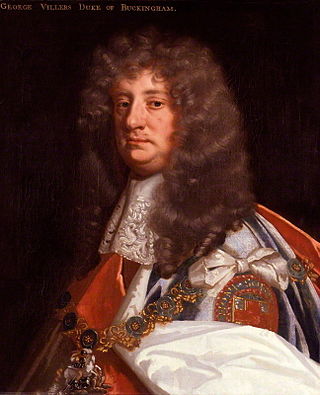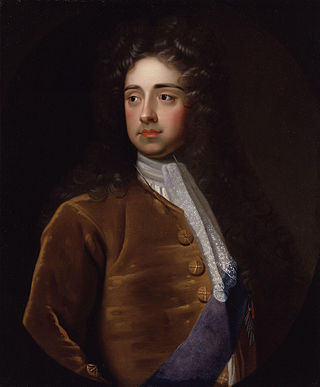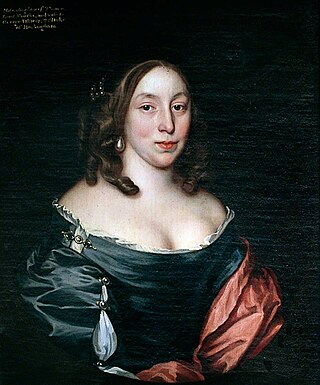Related Research Articles

George Villiers, 2nd Duke of Buckingham, 20th Baron de Ros, was an English statesman and poet who exerted considerable political power during the reign of Charles II of England.
This article presents lists of the literary events and publications in 1671.

Charles Talbot, 1st Duke of Shrewsbury was an English peer and Whig politician who was part of the Immortal Seven group which invited William of Orange to depose King James II of England during the Glorious Revolution. He was appointed to several minor roles before the revolution, but came to prominence as a member of William's government. Born to Roman Catholic parents, he remained in that faith until 1679 when—during the time of the Popish Plot and following the advice of the divine John Tillotson—he converted to the Church of England. Shrewsbury took his seat in the House of Lords in 1680 and three years later was appointed Gentleman-Extraordinary of the Bedchamber, suggesting he was in favour at the court of Charles II.

Henry FitzRoy, 1st Duke of Grafton, was an illegitimate son of King Charles II of England and his mistress Barbara Villiers. A military commander, Henry FitzRoy was appointed colonel of the Grenadier Guards in 1681 and Vice-Admiral of England from 1682 to 1689. He was killed in the storming of Cork during the Williamite–Jacobite War in 1690.

Earl of Shrewsbury is a hereditary title of nobility created twice in the Peerage of England. The second earldom dates to 1442. The holder of the Earldom of Shrewsbury also holds the title of Earl of Waterford (1446) in the Peerage of Ireland and Earl Talbot (1784) in the Peerage of Great Britain. Shrewsbury and Waterford are the oldest earldoms in their peerages held by someone with no higher title, and as such the Earl of Shrewsbury is sometimes described as the premier earl of England and Ireland.

Barbara Palmer, 1st Duchess of Cleveland, Countess of Castlemaine, was an English royal mistress of the Villiers family and perhaps the most notorious of the many mistresses of King Charles II of England, by whom she had five children, all of them acknowledged and subsequently ennobled. Barbara was the subject of many portraits, in particular by court painter Sir Peter Lely.

Eleanor Gwyn was an English stage actress and celebrity figure of the Restoration period. Praised by Samuel Pepys for her comic performances as one of the first actresses on the English stage, she became best known for being a long-time mistress of King Charles II of England.

Baron Greenwich was a title in the Peerage of the United Kingdom that has been created twice in British history.
Francis Talbot, 11th Earl of Shrewsbury, 11th Earl of Waterford, was an English peer who was a Royalist officer in the English Civil War. He survived the war only to be mortally wounded in a duel with the Duke of Buckingham who was having an affair with his wife.
Events from the year 1687 in England.
Events from the year 1640 in England.
Events from the year 1671 in England.
Events from the year 1684 in England.
Events from the 1520s in England.
Events from the 1620s in England. This decade sees a change of monarch.

Anna Maria Talbot, Countess of Shrewsbury was Countess of Shrewsbury from 1659 to 1668, by virtue of her marriage to Francis Talbot, 11th Earl of Shrewsbury.

Grafton Manor was established before the Norman Conquest. Grafton means "settlement at or near the wood" and may indicate a role in woodland management within a larger estate, for instance.
Villiers is an aristocratic family in the United Kingdom. Over time, various members of the Villiers family were made knights, baronets, and peers. Peerages held by the Villiers family include the dukedoms of Buckingham (1623–1687) and Cleveland (1670–1709), as well as the earldoms of Anglesey (1623–1661), Jersey, and Clarendon. Perhaps the most prominent members of the family were those who received the two dukedoms: George Villiers, 1st Duke of Buckingham (1592–1628) rose to fame and influence as favourite of King James I of England, while Barbara Villiers, Duchess of Cleveland (1640–1709) became a mistress of King Charles II of England, by whom she had five children.

Mary Villiers, Duchess of Buckingham, was the wife of George Villiers, 2nd Duke of Buckingham.

The Merry Gang was a group of aristocrats associated with the court of Charles II of England during the Stuart Restoration of 1660. The gang was centred on John Wilmot, 2nd Earl of Rochester, who stated their aim was to restore the idea of masculinity that had prevailed at the time of Henry II. They were also patrons of the arts, supporting the poet John Dryden and the dramatist Nathaniel Lee.
References
- ↑ "January 17th". Chambers' Book of Days. Archived from the original on 17 December 2007. Retrieved 2007-12-16.
- 1 2 Palmer, Alan; Palmer, Veronica (1992). The Chronology of British History. London: Century Ltd. pp. 190–191. ISBN 0-7126-5616-2.
- ↑ Penguin Pocket On This Day. Penguin Reference Library. 2006. ISBN 0-14-102715-0.
- ↑ Beauclerk, Charles (2005). Nell Gwyn: Mistress to a King . Atlantic Monthly Press. p. 128. ISBN 0-87113-926-X.
- 1 2 Uglow, Jenny (2010) [2009]. A Gambling Man. London: Faber. p. 458. ISBN 978-0-571-21734-2.
- ↑ Hall, Rupert (11 April 1996). Isaac Newton: adventurer in thought. p. 67. ISBN 9780521566698.
- ↑ Eisel, John C. (September 2014). "Stedman, Fabian (bap. 1640, d. 1713)" . Oxford Dictionary of National Biography (online ed.). Oxford University Press. doi:10.1093/ref:odnb/68907. ISBN 9780198614111 . Retrieved 2015-04-23.(Subscription or UK public library membership required.)